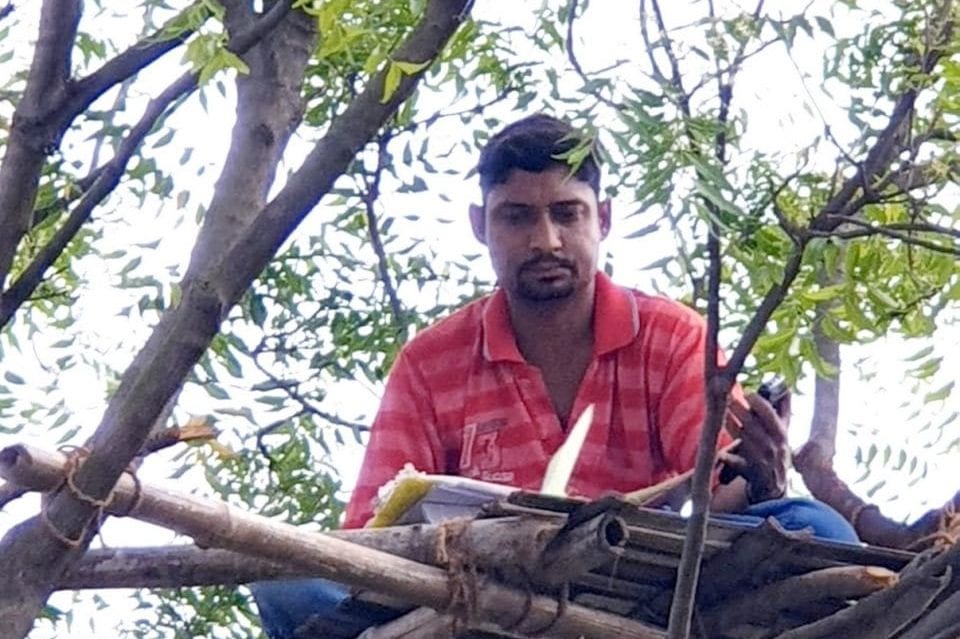
‘Work from tree’ by Bengal teacher lays bare India’s digital divide

The picture of a teacher working from a machan atop a neem tree in a Bengal village is the latest of the many connectivity-nightmare stories linked to rural India, punching a hole in the government’s digital inclusion push.
Subrata Pati, a teacher at a Kolkata-based educational institution that provides coaching for academic and competitive examinations, got into a fix when the institution started online classes after the central government declared a nationwide lockdown. Pati was stranded in his ancestral village of Ahanda in Bankura district, some 40 km off the district headquarters, due to the lockdown and didn’t have enough internet connectivity to take classes from there.
“I tried taking class from home. But due to poor internet connectivity, video calls got frequently disconnected and I was unable to send any attached files,” said the 35-year-old history teacher.
Necessity brings new ideas
The network, some villagers told him, was a little better near the river bank, situated on the village outskirts. But Pati realised that it wasn’t good enough to take an uninterrupted class of one-and-half hour.
Just as he was about to give up, it occurred to him that the connectivity might be better at a higher altitude. So, he climbed up a neem tree near the river, to explore his idea. To Pati’s delight, his assumption proved right.
Related news: Lockdown has changed lifestyle and internet searches prove that
After discovering the internet hotspot, Pati made a makeshift wooden platform, tied it to the tree’s branches and canopied it with a polythene sheet with the help of some friends.
“My daily routine these days is to climb up the tree in the morning with the teaching materials and food and climb down in the evening, spending about eight hours atop it,” he told The Federal over the phone. He works from 9.35am to 5.55pm with short breaks in between.
This improvisation, however, is not without hazards. Only a few days ago, Pati narrowly escaped a major accident, when his teaching platform gave way to a violent spell of Kalbaishakhi (northwester).
Villagers in this part of Bengal are used to making tree-top platforms, locally called machans to guard their crops against wild elephants. But nobody in the village ever imagined that the traditional skill would come handy in imparting long-distance history lessons.
Treetop, a proxy for network towers
Climbing trees to access mobile networks is, however, not an unknown manoeuvre in rural areas grappling with poor mobile and internet services.
Earlier this month, International Cricket Council’s international panel umpire Anil Choudhury posted on social media a few pictures of him trying to make a phone call from atop a tree at his ancestral village Dangrol in Uttar Pradesh’s Shamli district.
“I’m here with my two sons since March 16. The biggest problem is the network here. I can’t talk to anyone or use the internet. To be able to do that I have to go outside the village, climb up a tree or go to the rooftop. Also the network is not available all the time,” Chaudhary was quoted as saying by PTI-Bhasha.
A few years ago Jharkhand government’s ambitious biometric attendance scheme for government school teachers faced similar network hurdles in the villages of Palamu district. The local newspapers carried reports of how teachers at a school in Sohree Khas village in the district’s Satbarwa block used to climb up a tree to get their biometric attendance recorded on the tablet provided by the government after they discovered that the 2G network only “catches” on a particular tree branch.
Low internet penetration to rural pockets
According to data collected by the National Sample Survey as a part of the Survey on Education in 2014, only five per cent of students in rural India have access to the internet. The overall internet penetration in rural areas increased marginally from 9 per cent in 2015 to 25 per cent in 2018, according to another survey.
One of the reasons attributed by the survey for the poor penetration is lack of mobile connectivity in remote and far-flung areas. Acknowledging the deficiency, Parliament’s standing committee on finance, recently in a draft report on transformation towards a digital economy urged the government to urgently bridge the digital gap.
Related news: Internet speed, connectivity hinder DU profs from holding online classes
To bridge the rural-urban connectivity divide, particularly in security-risk areas, the Cabinet in November last year approved the construction of almost 207 towers in Bankura and four others in the Maoist-affected districts of West Bengal. The approval was part of the Ministry of Home Affairs’-identified telecom connectivity programme worth ₹2,194.83 crore for erecting 3,465 towers in Maoist insurgency-hit areas.
“After the submission of bidding, which was extended to February 24, the process got stuck due to the COVID-19 outbreak,” said a top official in the Department of Telecommunications.
To enhance broadband connectivity in rural areas, the official said a budgetary allocation of ₹6,000 crore was made for the Bharat Net programme in 2020-21. He, however, admits that the amount is too less to bridge the huge gap.


